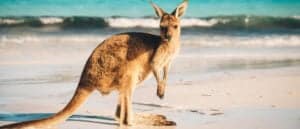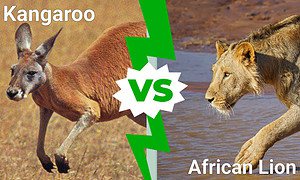Imagine if pregnant mothers could peek in on their growing baby. Not with an ultrasound, but with a live, up-close view. That’s what life’s like for a mother kangaroo whose pouch serves as a second womb. These marsupials get the opportunity to bond with and care for an undeveloped fetus, who starts life out about the size of a grape.
A kangaroo’s pouch is more than a complex pocket or built-in baby swing. This cozy safe haven is the ultimate nursery and we’re here to tell you all about it. Read on to discover what goes on inside a kangaroo’s pouch.
What’s Inside a Kangaroo Pouch?
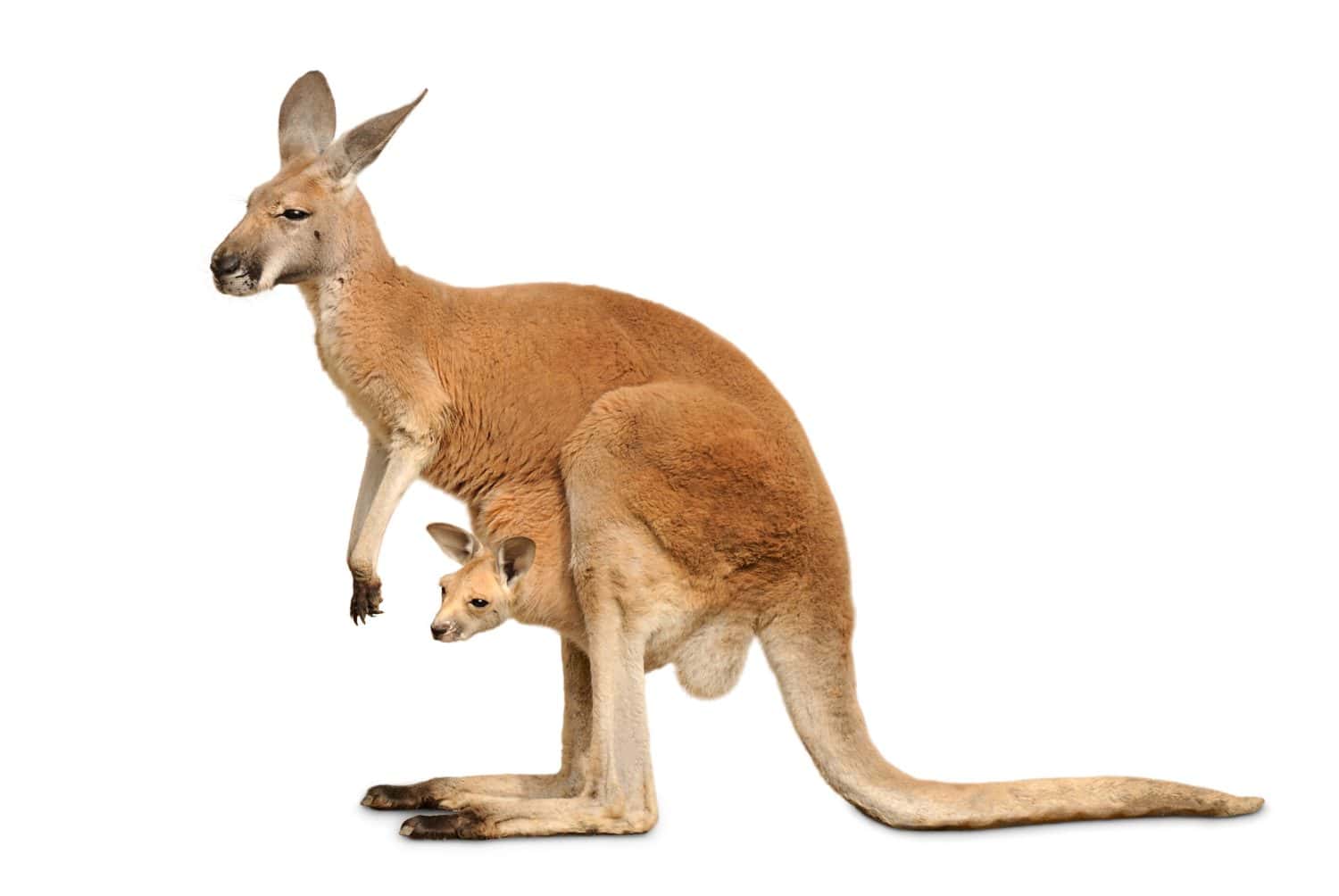
A kangaroo’s pouch is warm and contains four nipples, two on each side.
©Smileus/Shutterstock.com
The inside of a kangaroo’s pouch is hairless and warm and contains four nipples, with two on each side. The baby kangaroo, or joey stays tucked away suckling on one of the four milk ducts. Things can get really sweaty for the joey inside, especially as they grow larger. The pouch maintains a cozy temperature of around 105 degrees Fahrenheit, which is around the same temperature as the mother’s body.
Peeking in on a brand new kangaroo baby is a lot different than checking a more developed roo. Because it’s hairless, the inner pouch has a red fleshy skin color. It looks a bit like something out of a sci-fi movie. But it’s incredible nonetheless. Overall, the inside of a kangaroo’s pouch shows a behind-the-scenes look at how the baby develops.
The Pouch Is a Second Womb
Kangaroo babies are born after a 33-day gestation period, which is incredibly short, even for marsupials. These underdeveloped babies are blind, hairless, and deaf, and would never stand a chance out in the world. That’s where the pouch comes in. Since the underdeveloped roo isn’t ready for life, it uses the pouch as a second womb. It’s here that the little joey will be able to stay warm and nourished until it’s ready to strike out on its own.
Baby Kangaroos Are the Size of Jellybeans
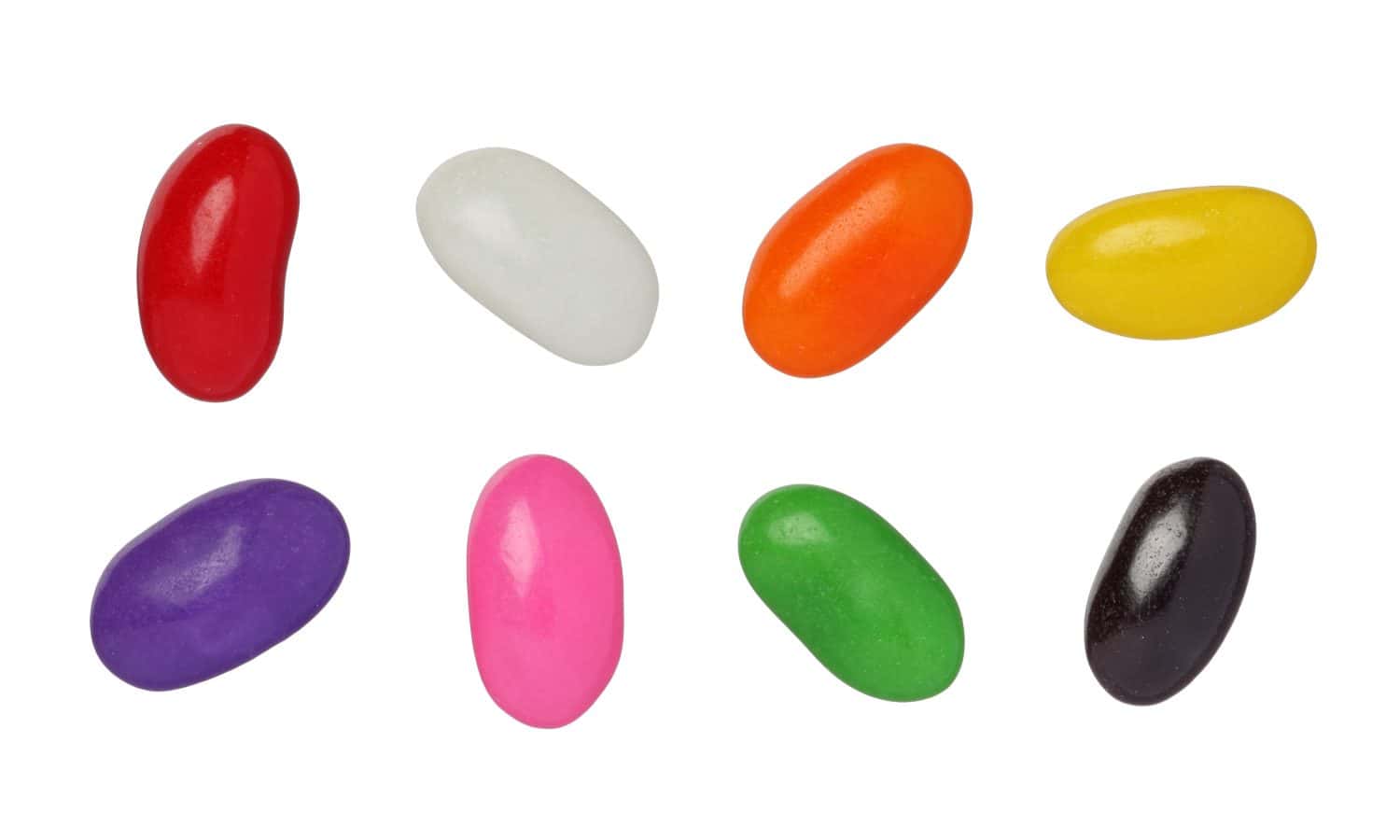
Newborn kangaroos are about the size of a jelly bean.
©mayakova/Shutterstock.com
A baby kangaroo is born tinier than your thumb. Sometimes they’re lovingly called “jellybeans” because they’re about the same size. These newborns are so tiny that they can be outweighed by a newborn house mouse.
Newborn joeys may be tiny, but they’re born with a lot of spirit. They have to be fiercely determined if they’re going to make the intense climb over the belly and into the pouch.
Kangaroos only give birth to one baby. When the joey is ready to be born, the female kangaroo sits up and begins grooming her pouch. Soon the baby will emerge from her cloaca, an opening at the base of her tail. Immediately after birth it begins to make its way into the pouch.
Saliva Trail Guides Baby
Mom kangaroos help guide the newborn to the pouch by licking a trail. But it’s up to the baby to put in all of the physical effort to complete the journey. If the joey isn’t able to complete the journey into the pouch, it won’t survive for long.
After giving birth, a kangaroo will lick a thick trail of saliva from the cloaca to one of the nipples (hidden in the pouch). Apocrine, the scents from skin glands, also guide the newborn joey to the pouch. The apocrine also plays a role in maintaining the right humidity inside the pouch.
The 3 minutes climb up into the pouch is a matter of life and death. Even with all of the scents guiding them to the pouch, it’s still difficult for the grape-sized joeys to scale all that fur.
Thankfully, newborn joeys have another advantage; strong arms! They’re born with sharp claws and somewhat developed arms. This is what makes it possible for them to scale their mother’s dense fur. Once they’re in the pouch, the joey will latch on to one of the four available nipples.
There Are Four Nipples Inside the Pouch
When the baby kangaroo is inside the pouch, it’ll look for a nipple. Once in their mouth, the thin long teat inflates and pokes down the joey’s throat. This helps hold the baby in place, as watery protein-rich milk begins slowly squirting out. The newborn will stay in this suckling position for a few months. Once their jaw develops they can unlatch and start suckling on their own.
Milk Provides Antibodies
A kangaroo’s milk provides her young with germ-fighting antibodies to prevent illness. Marsupial milk is rich in antimicrobial agents like immunoglobulins, lysozyme, transferrin, and cathelicidins. Cathelicidins are something a lot of animals produce to help kill or inhibit the growth of microorganisms like bacteria and fungi.
Pouches Are Super Stretchy
Similar to a pregnant belly, kangaroo pouches stretch to make room for the growing baby. Kangaroo bellies are super stretchy to accommodate the humongous baby they’re growing.
Even though joeys start off life the size of a lima bean, they don’t stay that way for long. An adult male red kangaroo can grow up to be larger than a human, standing 5 feet tall, and weighing up to 180 pounds. They’re one of the biggest marsupials roaming the planet.
Hairless Interior Promotes Skin-to-Skin Contact
Other than licking a pathway to the pouch, kangaroo moms aren’t very interested in their newborns. At least, not at first. Thanks to the skin-to-skin bonding the pouch provides, mother and baby form a powerful bond.
The famous skin-to-skin contact is possible thanks to a hairless pouch. The soft interior has the same soft texture as the mother’s skin. The cozy environment encourages a strong bond, as well as the stimulation needed for the normal development of things like chewing and movement.
Powerful Muscles and Ligaments
Within seconds a kangaroo pouch can go from loose and floppy to tight and secure. This ability is thanks to powerful muscles and ligaments lining the pouch. These muscles can either tighten to close things up, or completely relax to keep things nice and airy.
Large Sweat Glands Line Pouch
Large sweat glands lining the pouch release antimicrobial substances like lysozyme and dermcidin. Most of the glands rest right around the base of the nipple and in the skin pleats.
Lysozyme is a common and powerful antimicrobial found in a lot of animal secretions like sweat. Working together the dermcidin and lysozyme keep the joey safe from viruses, parasites, and bacteria.
Sphincter Muscle: How the Pouch Opens and Closes
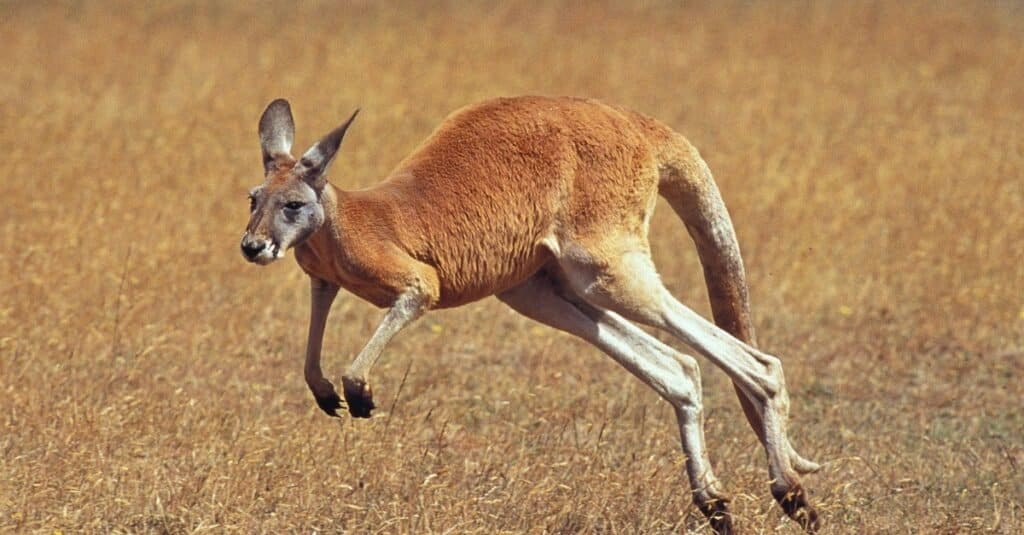
The sphincter muscle shuts the pouch tightly when the mother roo needs to hop or leap.
©iStock.com/slowmotiongli
The muscle at the opening of the pouch is the sphincter muscle. This important muscle helps close the pouch tight against the mother’s body. It’s almost like pulling a drawstring on the pouch.
When it’s time to hop around a kangaroo’s pouch goes from relaxed to tight. Kangaroos are fast and can cover 30 feet in a single leap! At full speed, they can go faster than 30 mph. Their anatomy is built for speed and power, as seen with their strong hind legs, big feet, and powerful tails.
As the pouch tightens, the joey presses hard against the mother’s belly. The pouch muscles act as a seatbelt, protecting the baby on its fast, and bumpy ride. Having this ability to move at top speeds, makes both mother and baby less vulnerable to danger.
Temperature Regulation
The sphincter muscle also helps with keeping things at the right temperature. For the jellybean-sized baby to develop, the pouch has to maintain a warm temperature. But once the joeys are a few months old, and have fur of their own, things don’t have to stay so hot.
On hot days, it’s normal for a kangaroo mom to keep the pouch loose and aired out. The stretchy pocket becomes almost like a hammock for the joey to stretch out in.
Kangaroo Moms Can Suspend a Pregnancy
Once a mother roo becomes pregnant for the second time, she can pause the pregnancy. Embryonic diapause is something wallabies can do too. Here’s how it works:
The second baby develops to a certain point and then waits to continue growing. If the first baby doesn’t survive, the mom will be able to quickly fill the void with the second baby. And if both babies survive her nipples can provide different age-related milk compositions.
A female kangaroo may have as many as four joeys in a single year. She can have up to three at a single time; one in the womb, one in the pouch, and one on foot. This is another one of the reasons she has four nipples.
Sometimes all of the joeys will have the same father. After a single mating session, the mother roo will have four viable pregnancies. Her body will give birth to the first baby and delay implanting the other embryos. When the first baby can explore outside of the pouch, the second pregnancy will begin.
Kangaroo Milk Composition Changes as Joey Develops
A kangaroo’s milk has the amazing ability to change composition as the baby develops. Her body’s able to tune into what the baby needs for every stage of growth. If the mother is nursing more than one joey, each nipple can offer a different type of nutrient makeup.
For newborns, the watery milk has simple carbs is high in protein, and focuses on strengthening their immune system. This composition helps the jellybean baby get all of the nutrients to develop, while also fighting off sickness. The immunological protection is especially helpful since the pouch isn’t a sterile environment.
As the joey ages, the milk composition changes to be higher in protein, carbs, and a bit of fat. This new makeup helps them make rapid developments. Then, when they’re even bigger they’ll get a lot of fat and protein in the milk composition, but low carbs.
Sulfur, which contains a lot of hair-growing proteins, starts showing up in the milk composition when the joey is around three months old. Once sulfur arrives, the little pink joey will start growing fur.
The amazing milk-providing abilities don’t stop there. If a kangaroo has two joeys who are different ages, she can create different compositions for each one. Different nipples will provide different nutrients.
How Mother Roos Keep the Pouch Clean
Things can get pretty messy inside a kangaroo pouch. And it’s up to the mother roo to keep the nursery clean. Using their long snout and tongue, they’re able to remove any dirt, feces, or urine.
In the beginning, there isn’t a whole lot of cleaning up to do. The only messes are the poops and pee’s the mother helps manage. When the time’s right the mother gently pokes her head inside the pouch and licks the baby roo to stimulate the need to go. She’ll gently lick the genitalia, and if the baby needs to go it will, and the mother licks it up.
Dirt starts to enter the scene when the joey is old enough to leave the pouch. The curious explorer tracks in all sorts of dirt and debris, and sometimes while sharing the pouch with a small sibling. When this is the case the mom will make the big kid wait outside the pouch while she tidies up.
When Does the Joey Leave the Pouch?

At around five months old a joey will stick its head out of the pouch for the first time.
©K.A.Willis/Shutterstock.com
A joey permanently leaves the pouch at around eight to 10 months old. When talking about the age of a baby kangaroo, it helps to use “out of the pouch” terms. If you hear someone say a joey’s been “out of the pouch for a week”, they’re talking about an eight to 10-month-old joey who left the pouch a week ago.
Growth Stages
A newborn joey constantly nurses for the first 70 days of life. After that, its jaw’s developed enough that it can self-suckle, but it still has to stay tucked away in the pouch.
Finally, by five months, the little roo is ready to poke its head out of the pouch. They can get a good look at what’s going on in the world, however, they’re still not ready to step foot on the ground.
Around six months leaves the pouch, and usually by falling out. After a clumsy entrance, it’s time to start hopping around to explore the world. The older the joey gets, the more time it’ll spend outside of the marsupium or pouch.
After eight to 10 months what began as a gummy bear-sized baby will reach the size of a small dog. At this stage, the baby’s outgrown the nursery. But that doesn’t mean they’re independent.
Even after leaving the pouch for good, a kangaroo needs its mother’s milk. They’ll stay with her and continue to nurse until about a year old. Sometimes joeys will suckle for up to two years. After they fully wean they begin foraging for food.
How Joey’s Enter the Pouch
How does a baby kangaroo re-enter the pouch? Like a gymnast. At the first hint of danger, a joey will somersault into its mother’s pouch. The forgiving pouch is extra stretchy so it can take in the youngster, elbows, and all. Sometimes this somersaulting motion takes place at high speeds as the joey rushes to reach its mother.
If you’ve ever seen a video of a joey hopping back into the pouch, you know just how skilled these little ones are. First, they grip the rim of the pouch with their forepaws. Diving headfirst, they’ll keep somersaulting until their right side up again. Then with a quick twist, they can face out of the pouch, resting their arms on the rim.
The photo featured at the top of this post is © K.A.Willis/Shutterstock.com
Thank you for reading! Have some feedback for us? Contact the AZ Animals editorial team.




